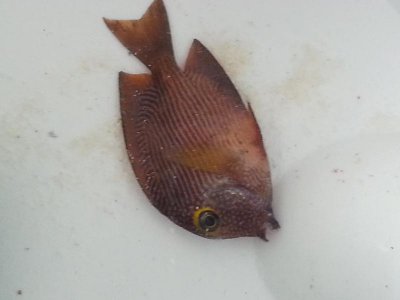tcorriveau
New member
Last night when I went to bed, all seemed fine with all my fin friends. When I woke up this morning and gave them breakfast, everyone was accounted for and enjoying some Mysis shrimp. Approximately two hours later, my roommate called and stated two of my fish were dead. I asked him to test the water for me just to make sure it wasn't the water and the results are below:
1.025 SG
Calcium 525
Carbonate = 12dkh
High range PH = 8.2
Ammonia = .25
Phosphate = 0
Nitrate = 0
Nitrite = 0
To be safe, I plan to purchase the materials to conduct a TTM and treat for ich and infections after work, but I am curious as to why two fish that seemed perfectly healthy died in the matter of a couple of hours. I asked my roommate if he noticed if they were in distress before passing, he stated the Kole Eye Tang was laying on the sand bed and appeared to be gasping for air, but the yellow head jaw fish did not appear to be in distress and was in the process of moving his den location. My roommate was also nice enough to take some water to the LFS and their tests results were similar. Any ideas?
The flow in my tank consists of three power heads, one causes water to flow behind all the live rock, one is at the top of the tank moving water in a downward motion and the other is located at the bottom moving water to the top. I also have a Reef Octopus BH100 skimmer and a mechanical filter large enough for a 100g tank.
The other inhabitants in the tanks consist of several snails, two peppermint shrimp, a fire shrimp, two emerald crabs, green hammer coral, green star polyp, two Duncan corals, a waving hand coral, two ocellaris clownfish, two fire fish, two Kaudern's cardinals, a Fiji blue devil damsel, a lawnmower blenny, yellow head jaw fish, and a brittle star.
Oh and on a side note, the two fish that died were from live aquaria and all the other inhabitants were purchased from the LFS. I have included a picture of the tang for viewing and all the white dots are sand that washed off before I disposed of the fish. Also, I posted this same question in the New to Hobby section before I was referred here. A lot of my tank specs are in the original thread, but I am happy to re-answer any questions pertaining to that. I am leaving work now and heading to the LFS for supplies. One person mentioned velvet due to the coloration around the stomach area behind the gills.
1.025 SG
Calcium 525
Carbonate = 12dkh
High range PH = 8.2
Ammonia = .25
Phosphate = 0
Nitrate = 0
Nitrite = 0
To be safe, I plan to purchase the materials to conduct a TTM and treat for ich and infections after work, but I am curious as to why two fish that seemed perfectly healthy died in the matter of a couple of hours. I asked my roommate if he noticed if they were in distress before passing, he stated the Kole Eye Tang was laying on the sand bed and appeared to be gasping for air, but the yellow head jaw fish did not appear to be in distress and was in the process of moving his den location. My roommate was also nice enough to take some water to the LFS and their tests results were similar. Any ideas?
The flow in my tank consists of three power heads, one causes water to flow behind all the live rock, one is at the top of the tank moving water in a downward motion and the other is located at the bottom moving water to the top. I also have a Reef Octopus BH100 skimmer and a mechanical filter large enough for a 100g tank.
The other inhabitants in the tanks consist of several snails, two peppermint shrimp, a fire shrimp, two emerald crabs, green hammer coral, green star polyp, two Duncan corals, a waving hand coral, two ocellaris clownfish, two fire fish, two Kaudern's cardinals, a Fiji blue devil damsel, a lawnmower blenny, yellow head jaw fish, and a brittle star.
Oh and on a side note, the two fish that died were from live aquaria and all the other inhabitants were purchased from the LFS. I have included a picture of the tang for viewing and all the white dots are sand that washed off before I disposed of the fish. Also, I posted this same question in the New to Hobby section before I was referred here. A lot of my tank specs are in the original thread, but I am happy to re-answer any questions pertaining to that. I am leaving work now and heading to the LFS for supplies. One person mentioned velvet due to the coloration around the stomach area behind the gills.

